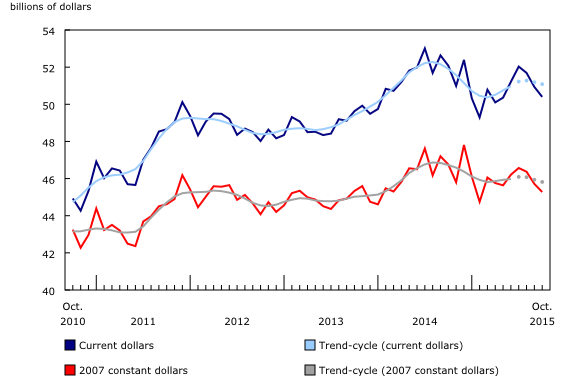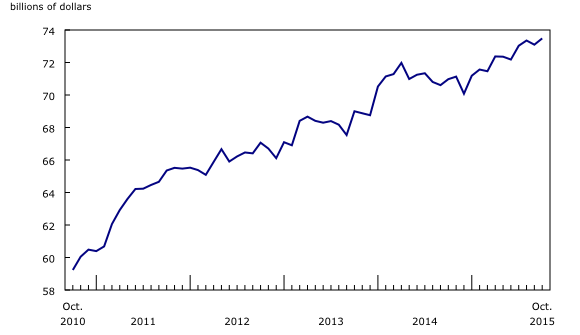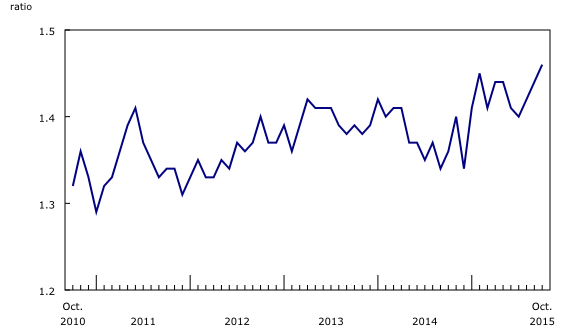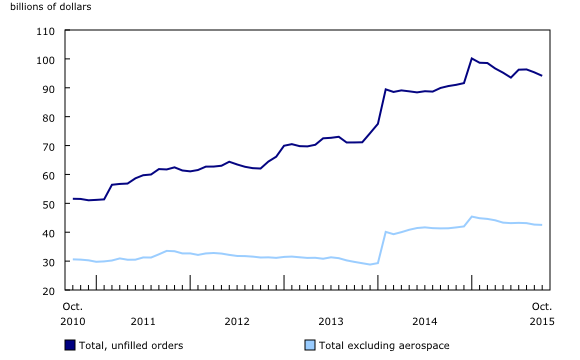Monthly Survey of Manufacturing, October 2015
Archived Content
Information identified as archived is provided for reference, research or recordkeeping purposes. It is not subject to the Government of Canada Web Standards and has not been altered or updated since it was archived. Please "contact us" to request a format other than those available.
Released: 2015-12-15
Manufacturing sales declined 1.1% to $50.4 billion in October, the third consecutive decrease. Declines in the petroleum and coal product, aerospace product and parts, and machinery industries were responsible for the overall drop.
In constant dollar terms, sales were down 1.0%, indicating that lower volumes of manufactured goods were sold.
Declines in the petroleum and coal product, aerospace product and parts, and machinery industries
Sales were down 5.7% to $4.5 billion in the petroleum and coal product industry, the fifth consecutive decline. The decrease in October reflected lower production of refined products. Maintenance and turnaround work at some refineries that began in September continued into October. Although shutdowns for maintenance and turnaround work often occur in September and October, this year the shutdowns were more extensive than usual. Prices, as reported by the Industrial Product Price Index, were down 1.1%. With this latest decline, sales in the industry were at their lowest level since April 2009 ($4.2 billion).
Production in the aerospace product and parts industry fell 10.3% to $1.6 billion. Aerospace production is substantially more volatile compared with the manufacturing sector as a whole. Hence, the decrease in October was not unusually large for the industry. Nevertheless, with this decline, production for the three-month period ending in October was 7.2% lower than the previous three-month period.
Machinery sales fell 4.6% in October to $2.8 billion, largely reflecting lower sales in the commercial and service machinery manufacturing sub-industry. Manufacturers in this sub-industry produce a variety of machines used in the retail and service industries, such as cash registers, photographic equipment, vending machines and simulation equipment. Sales in the sub-industry tend to fluctuate on the basis of the completion of large projects.
Sales also decreased in the primary metal (-2.4%) and the miscellaneous (-6.6%) industries. Declines were widespread in both industries.
The sales declines were partly offset by higher sales in the motor vehicle industry. Motor vehicle sales rose 4.9% to $5.3 billion in October, as a result of higher volumes of vehicles produced. This was the fifth increase in six months. Sales in the industry since the beginning of the year were 7.4% higher compared with the same period (January to October) in 2014.
Sales down in five provinces
Sales declined in five provinces in October, with New Brunswick posting the largest decrease in dollar terms.
In New Brunswick, sales fell 23.9% to $1.1 billion in October, as a result of lower non-durable goods sales. Manufacturing sales in the province have been on a generally downward trend since April 2015, when they were $1.5 billion. Since then, sales have declined 28.2%.
Sales in Quebec declined 2.1% to $11.8 billion in October. The decrease was mostly caused by a 13.3% drop in the aerospace product and parts industry. Sales were also down in the food (-2.5%) and primary metal (-2.4%) industries.
Alberta manufacturing sales were down 1.9% to $5.5 billion in October, the 9th decline in 12 months. On a year-to-date basis, sales were 13.2% lower than the same period in 2014. In October, lower sales in the chemical and machinery industries were responsible for the provincial decrease. In the chemical industry, sales fell 6.2% as a result of widespread declines. Machinery sales decreased 11.4%, mostly because of a drop in the mining and oil and gas field equipment manufacturing sub-industry. Some companies in this sub-industry cited that falling demand stemming from challenges in the oil and gas extraction sector have affected their sales. Sales of mining and oil and gas field equipment are closely tied to activity in the oil and gas extraction sector.
In Ontario, sales rose 0.6% to $24.4 billion, offsetting some of the declines in the other provinces. The gain stemmed from a 4.8% increase in the motor vehicle assembly industry. This was the fifth sales increase in the motor vehicle assembly industry in six months.
Inventories rise
Inventories rose 0.5% to $73.5 billion in October, as a result of gains in the transportation equipment industry and the computer and electronic product industry. A 2.7% decline in primary metal inventories offset a portion of the gains.
In the transportation equipment industry, inventories of aerospace products rose 2.1% to $9.1 billion, the fourth consecutive monthly advance. Computer and electronic product inventories rose 6.1% to $2.8 billion. Gains in the industry were widespread.
The inventory-to-sales ratio increased from 1.44 in September to 1.46 in October. The inventory-to-sales ratio measures the time, in months, that would be required to exhaust inventories if sales were to remain at their current level.
Unfilled orders decline
Unfilled orders decreased 1.3% to $94.1 billion in October, largely as a result of lower unfilled orders in the aerospace product and parts industry.
In the aerospace industry, unfilled orders were down 2.1% to $51.6 billion. The decline mostly reflects a 2.3% decrease in the value of the US dollar relative to the Canadian dollar between September 30 and October 30. Most unfilled orders in the aerospace industry are held in US dollars.
New orders fell 1.4% in October, the third consecutive decline. New orders were down in the transportation equipment, petroleum and coal product and primary metal industries.
Note to readers
Monthly data in this release are seasonally adjusted and are expressed in current dollars unless otherwise specified. For information on seasonal adjustment, please refer to the following document: Seasonally adjusted data – Frequently asked questions
For more information on the trend-cycles, see Trend-cycle estimates – Frequently asked questions.
Non-durable goods industries include food, beverage and tobacco products, textile mills, textile product mills, clothing, leather and allied products, paper, printing and related support activities, petroleum and coal products, chemicals, and plastics and rubber products.
Durable goods industries include wood products, non-metallic mineral products, primary metal, fabricated metal products, machinery, computer and electronic products, electrical equipment, appliances and components, transportation equipment, furniture and related products and miscellaneous manufacturing.
Production-based industries
For the aerospace industry and shipbuilding industries, the value of production is used instead of sales of goods manufactured. This value is calculated by adjusting monthly sales of goods manufactured by the monthly change in inventories of goods in process and finished products manufactured. Production is used because of the extended period of time that it normally takes to manufacture products in those industries.
Unfilled orders are a stock of orders that will contribute to future sales assuming that the orders are not cancelled.
New orders are those received whether sold in the current month or not. New orders are measured as the sum of sales for the current month plus the change in unfilled orders from the previous month to the current month.
Manufacturers reporting in US dollars
Some Canadian manufacturers report sales, inventories and unfilled orders in US dollars. These data are then converted to Canadian dollars as part of the data production cycle.
For sales, based on the assumption that they occur throughout the month, the average monthly exchange rate for the reference month (noon spot rate) established by the Bank of Canada is used for the conversion. The monthly average exchange rate is available in CANSIM table 176-0064.
Inventories and unfilled orders are reported at the end of the reference period. For most respondents, the noon spot exchange rate on the last working day of the month is used for the conversion of these variables. However, some manufacturers choose to report their data as of a day other than the last day of the month. In these instances the noon spot exchange rate on the day selected by the respondent is used. Because of exchange rate fluctuations, the noon spot exchange rate on the day selected by the respondent can differ from both the exchange rate on the last working day of the month and the monthly average exchange rate. Noon spot exchange rate data are available in CANSIM table 176-0067.
Revision policy
Each month, the Monthly Survey of Manufacturing releases preliminary estimates for the reference month and revised estimates for the three previous months. Revisions are made to reflect new information provided by respondents, and updates to administrative data. Once a year, a revision project is undertaken to revise multiple years of data. During annual revisions, changes are made to the seasonal adjustment parameters.
Real-time CANSIM tables
Real-time CANSIM tables 304-8014, 304-8015 and 377-8009 will be updated on December 24. For more information, consult the document Real-time CANSIM tables.
Next release
Data from the November 2015 Monthly Survey of Manufacturing will be released on January 20, 2016.
Contact information
For more information, contact us (toll-free 1-800-263-1136; 514-283-8300; STATCAN.infostats-infostats.STATCAN@canada.ca).
To enquire about the concepts, methods or data quality of this release, contact Michael Schimpf (613-863-4480; michael.schimpf@canada.ca), Manufacturing and Wholesale Trade Division.
- Date modified:







